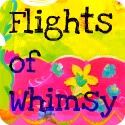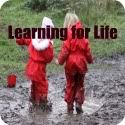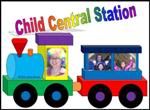I would have to say that upon reflecting on my own personal experiences growing up in the late 60’s, early 70’s (see CHILDHOOD MEMORIES OF THE GREAT OUTDOORS) and also taking into account the plethora of research, books and journal articles that have been dedicated to this issue, I am convinced that we have definitely lost direction over the last few decades when it comes to children’s access to outdoor play. With this in mind, I can not tell you how excited I was to stumble across this little reminder of how things were once upon a time when I was young.
Friends who know me well, are aware of my habitual tendency to venture into at least one Opportunity Shop (Thrift Shop) each weekend to rummage around for useful resources. Actually, such shops are a common site to find fellow early childhood professionals, all on a similar mission really. One of my favorite pass times is to browse through the collections of second-hand books as a means of cheaply supplementing our preschool library (see GREAT PLACES TO PURCHASE USEFUL RESOURCES ON A TIGHT BUDGET). But when I stumbled across this little gem, I just had to claim it all for myself!
This gorgeous book, ‘Kites and Swings and Other Things: The Four Seasons in Poems and Pictures for Children’, by Barbara Kunz Loots and Rick Lyons, is like a heart-warming stroll down memory lane. Lost within it pages, your imagination can almost detect the fragrant signatures of each seasons. Published in 1974, it is unfortunately no longer in print, although it is available on amazon for around $50 second-hand. Eeek! I paid a mere 50 cents for it!
The photographic images in the book are absolutely delightful and I have chosen a selection to show you here. They visually speak of a time when the pace of life was slower and simpler and children had an abundance of unscheduled time to play and explore to their heart’s content, and significantly, out of reach of the prying eyes of hovering parents. You see, Helicopter parents just didn’t exist in those days.
Recently I was fortunate enough to hear the wonderful Tim Gill speak on the topic, EXPANDING CHILDREN’S HORIZONS. Tim, and many other amazing experts in the field of children’s play, have become outspoken , powerful advocates for turning back the clock and re-establishing the rights of all children to play outdoors independently. Tim is the author of ‘No Fear: Growing Up in a Risk-averse Society’ (also available on amazon) and is the co-author of ‘Play England: Making Spaces for Play. Managing Risk in Play Provisions: Implementation Guide’ (PDF). You can also read more from Tim on his website RETHINKING CHILDHOOD. Well worth a visit and a browse.
To commence Tim’s presentation, he encouraged the audience to explore their own childhood memory bank and halt at a play experience that resulted in feelings of joy and happiness. Not surprisingly, it was discovered that the bulk of the audience shared memories of experiences that took place in the outdoor environment. Tim went on to explain that the places and experiences that tend to resonate with most people when they reflect upon their childhood, predominately feature:
- The outdoors,
- Out of direct adult supervision, and were
- Paired with a sense of adventure.
Furthermore, he noted that while society’s attitudes towards outdoor play have changed, the innate need for children to be connected to the natural environment has not changed.
He suggested that the reason why these experiences appear to universally resonate is because they:
- Feed children’s desire for autonomy and agency, and
- Feed children’s desire ‘to know’.
Tim warned that the current Zero Risk approach that embraces the bubble wrap, cotton wool mentality towards raising children, embodies a complete 180 degrees turn away from what is in the best interests of children. This risk-averse approach has become such a preoccupation in western societies that it totally overrides any reference towards the needs or interests of children.
Tim pointed out that the most significant change in children’s lives today has been the reduction in their Right to Roam. Over the past few decades the boundaries limiting children’s freedom of movement away from their family home have been shrinking, and along with that, children have been losing their autonomy as they are increasingly placed under the burdened of greater adult control and supervision.
But I would have to say that the most profound notion that I will take away from Tim’s presentation was his suggestion that we need to re-connect with the lost art of Benign Neglect. What a brilliant concept, and one I am certainly going to introduce to the parents of the children within my care.
So much freedom is represented in these two simple words, Benign Neglect. Two apparently contradictory words that have the potential to free parents from the often intense pressure placed on them by society to be perfect in their parenting role and to eliminate all possible risk from their children’s lives. Clearly an impossible expectation and one that leaves parents riddled with guilt when they fall short of the task. Parents need to know that by over protecting their children they may in fact be doing them harm. Children need to be granted the autonomy to develop skills in managing risks and opportunities to improve their capacity for self-initiated risk assessment. These skills are fundamental life skills and have been since the dawn of time.
With every circumstance that instills the fear of risk in the mind of parents there must be an equally balanced and rational assessment of the possible benefits to their child. A little neglect in this day and age, could very well prove to be a really good thing. We just need to get parents believing it.
I don’t feel that I can end this post without acknowledging the work of the inspirational Richard Louv, author of the landmark book, ‘Last Child in the Woods: Saving our Children from Nature Deficit Disorder’ (also available on amazon) and the founder of THE CHILD AND NATURE NETWORK. A must have book for all early childhood educators and a great website to investigate.
































I often get these pangs of sadness when I think of how much children are micromanaged and not allowed to explore and discover the world untethered from adults. I too scour the thrift shops for ‘vintage’ books of interest. It’s sad to think that children’s play could now be thrown amongst the pile of thift store finds and considered ‘vintage’.
Ah yes Leeanne, you and I are kindred spirits when it comes to recycling resources! 😉
Wow! Karen, what a find!!!! It is so perfect for you, too. The universe was smiling on you, for sure.
My thoughts exactly Lesley! I am not sure if the sales assistant could quite grasp my excitment! 🙂
That looks like a great book with some beautiful pictures and memories! I know my kids are at their happiest when they get to go off with their friends, away from the adults and explore the outdoors!
Yes, so true Jill. The sheer delight and happiness can be seen on the faces of the children within this book and no doubt you witness the same joy on the faces of your own children. I am glad that you found this post relevant to your circumstances and thank you for dropping by! 🙂
Thanks for such a generous, enthusiastic, thoughtful take on my talk Karen – and for such a stimulating post. The book you found looks like a gem (I too like browsing 2nd-hand bookshops, but have never found anything as good as that). I wonder if you have come across the books written by Fiona Danks and Jo Schofield? They are delightful – beautifully put together ‘recipes’ for outdoor play. Their first, Nature’s Playground, is almost coffee-table. The more recent ones – including one on ‘bad weather play’ and one solely on sticks – are more ‘outdoor-friendly’ but still lovely as books and full of great ideas. Anyway, nice to make contact here!
Thank you Tim. I was so pleased to have had the opportunity to hear you speak. Something I had been hoping to achieve for quite some time. We have actually made contact before. At that particular presentation (St Kilda Town Hall in Melbourne), you sat next to me while you waited to be introduced and we had a brief chat. It was lovely to see what a genuinely nice guy you are and just how articulate and passionate you are about your work. I provided the staff at my service with summary notes from your presentation and will also be doing the same for our parents.
I will definitely follow up on the books you mention, and perhaps add them to my collection.
Thanks again for the inspiration Tim! 🙂
I love this post. Thank you. also, I love to play with song and the poem by Robert lewis Stevenson you can sing to the tune of ‘sing a song of sixpence’. I will be adding this post to the FB page of the group I work for Frosty Pines wilderness Education. this is so important. 🙂
Thank you. I am so glad the post resonated with you! 🙂
Beautiful, beautiful, beautiful! Lost art of benign neglect… I will definitely share your post with my teaching community. Thank you Tim and thank you Karen. This is so relevant to my school in Singapore. We are as it is limited by space, and the lost art…. adds to the woes of teaching and learning. We are in the process of re-thinking as a school, outdoor areas and experiences that nurture growth and this post is beautiful and timely!
I am glad it was of relevance to your personal experiences. Thank you. 🙂
What a great article Karen! You have worded what many educators and parents are thinking so succinctly and clearly, thank you. I love the term ‘benign neglect’ – it’s perfect! Cheers – Shar
I am pleased this post had meaning for you Shar. 🙂
Thank you for this nice blog article! I was lucky enough to grow up with lots of woods and wildlife (I even lived next to a wildlife sanctuary!), and had parents that allowed me to play around by myself (well, I had my dogs!). I’m a nanny, and I have to say, having been one for nearly 10 years, I’ve seen many kids micromanaged and stressed out–at the age of 5. I rarely see kids running around climbing trees.
I really hope more people see your blog and read that book. I distinctly remember as a child playing with other kids wanting, NEEDING, to escape parents to play in our own world. It’s natural. And I know if I had had my parents constantly eyeing me over my shoulder I never would have learned to make safety judgement for myself, or learn to listen to that inner voice. Nor would I have learned how to negotiate and compromise.
One of the families I nannied for I took to a creek and woods and I let them play and go out of my sight (I could hear them though) and let me tell you, hearing their shouts of delight and their imaginations taking hold, it was wonderful! All without me having to ‘be there’. After that, they begged me every day to take them back so they could find more plants, build walls with rocks and trees in the creek. I was happy to oblige! And through that play the children who usually fought with each other learned to take care of one another and LISTEN and compromise. Yay Mother Nature! <3
[…] Playing Outside: The Lost Art […]